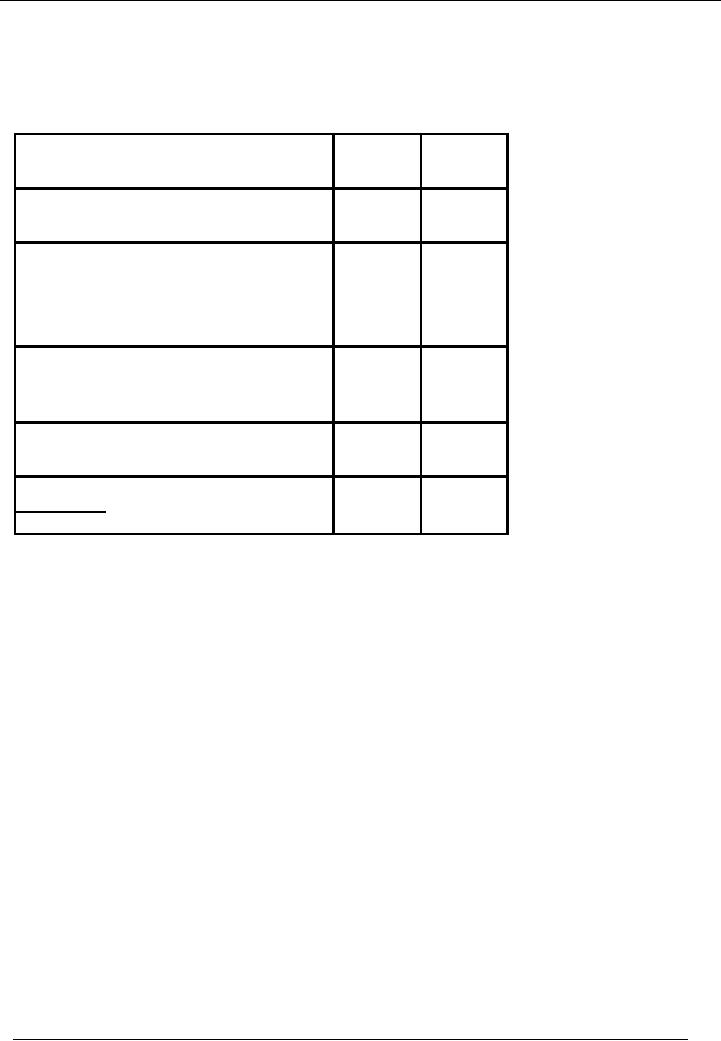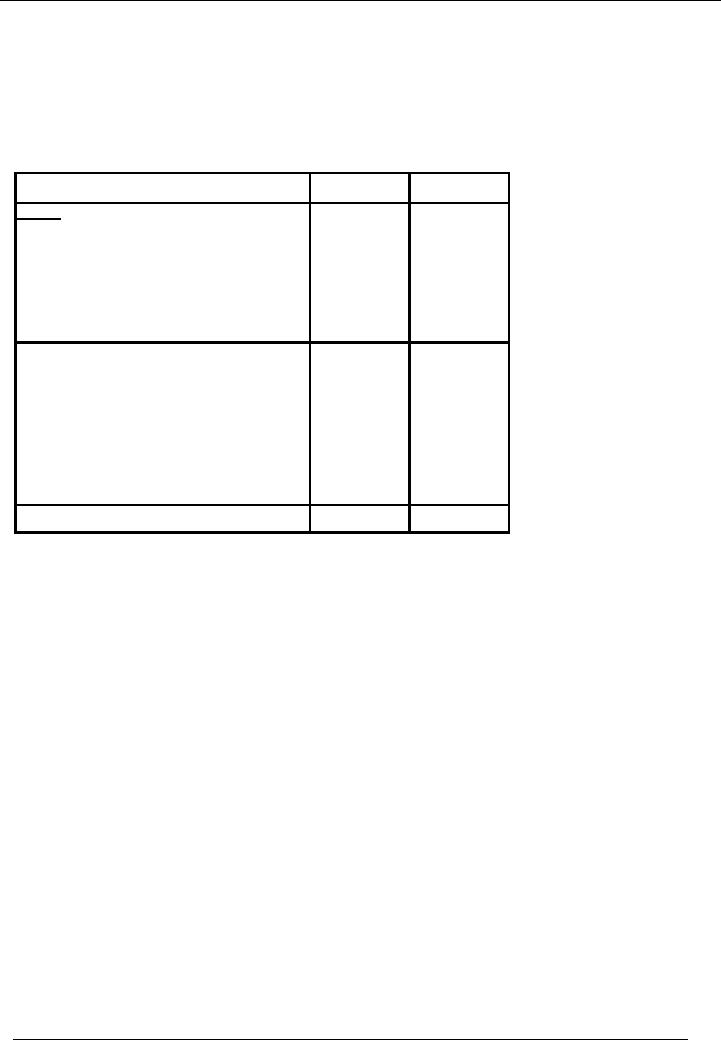 |
STANDARD FORMAT OF PROFIT & LOSS ACCOUNT |
| << RECTIFICATION OF ERROR |
| STANDARD FORMAT OF BALANCE SHEET >> |

Financial
Accounting (Mgt-101)
VU
Lesson-29
STANDARD
FORMAT OF PROFIT & LOSS
ACCOUNT
Standard
format of profit & loss
account is shown as
follows:
Particulars
Amount
Amount
Rs.
Rs.
Sales
X
Less:
Cost of Goods Sold
(X)
Gross
Profit
X
Less:
Administrative Expenses
Selling
Expenses
X
X
(X)
Operating
Profit
X
Less:
Financial Expenses
(x
)
Add :
Other income
Profit
Before Tax
X
Less:
Tax
(X)
Net
Profit After Tax for the
Year
X
Other
income
SALES
·
Sales
as we know are the revenue
against the sale of the product in
which the organization deals.
·
In
case of a service organization, there
will be Income against
Services Rendered instead of
Sales
and
there will be no Cost of
Sales or Gross
Profit.
COST
OF GOODS SOLD/GROSS
PROFIT
·
Cost
of goods sold is the cost incurred in
purchasing or manufacturing the product,
which an
organization is
selling plus any other
expense incurred in bringing the product
in salable condition.
Cost
of goods sold contain the following
heads of accounts:
o Purchase
of raw material/goods
o Wages
paid to employees for manufacturing of
goods
o Any
tax/freight is paid on purchases
o Any
expense incurred on carriage/transportation of
purchased items.
·
Gross
Profit = Sales Cost of
goods sold
OTHER
INCOME
· Other
income includes revenue from
indirect source of income,
such as return on investment,
profit
on PLS
account etc.
194

Financial
Accounting (Mgt-101)
VU
ADMINISTRATIVE
EXPENSES
·
Administrative
expenses are the expenses incurred in
running a business effectively.
Main
components
of this group are:
o Payment
of utility bills
o Payment
of rent
o Salaries
of employees
o General
office expenses
o Repair
& maintenance of office equipment &
vehicles.
·
It is
important to distribute expenses
properly among the three
classifications i.e. Cost of
Goods
Sold,
Administrative Expenses and
Selling Expenses to present the financial
statements fairly.
Take
the
example of following
costs:
o Salaries
and Wages
Although
both these terms mean
remuneration paid to labour and
employee
against
services.
Wages
usually denotes remuneration paid to daily
wages labour. Whereas
salary
denotes
payments to permanent
employees.
Salaries
can be classified in any of the
classifications mentioned below.
· Salaries
/ wages paid to labour and
supervisors/officers working for
the
manufacturing of
goods become a part of Cost
of Goods Sold.
· Salaries
and benefits of general administrative staff
becomes part of
Administrative
Expenses
· Salaries
and benefits of sales and marketing staff
become part of
selling
expenses.
·
Other
expenses like Depreciation, Utilities
and Maintenance can also be
classified in all
three,
depending
upon the exact nature of the
expenditure.
SELLING
EXPENSES
·
Selling
expenses are the expenses incurred
directly in connection with the sale of
goods. This head
contains:
o Transportation/carriage
of goods sold
o Tax/freight
paid on sale
·
If the
expense head `salaries'
includes salaries of sales staff. It
will be excluded from
salaries &
appear
under the heading of `selling
expenses'.
FINANCIAL
EXPENSES
·
Financial
expenses are the interest paid on bank
loan & charges deducted by bank on
entity's bank
accounts.
These are shown separately
in the Profit and Loss
Account. These
includes:
o Interest
on loan
o Bank
charges
·
There
is, however, one exception and
that is the interest paid on loan
taken to build an asset
is
capitalized
as cost of the asset up to the time that
asset is completed.
INCOME
TAX
·
Different
types of entities have to pay
income tax at different
rates.
·
At the time of
preparing annual financial statements, an
estimate of expected tax liability is
made.
·
A
provision is then, created equal to
that estimate.
195

Financial
Accounting (Mgt-101)
VU
·
You
should remember the treatment of Provision
for Doubtful debts. Same is
the case with income
tax
i.e. provision is made at the time of
preparing accounts which is then
adjusted accordingly at the
time when
actual tax expense is
known.
BALANCE
SHEET (ASSET
SIDE)
Standard
format of the balance sheet is given as
follows:
Particulars
Amount
Rs.
Amount
Rs.
Assets
Non
Current Assets
Fixed
Assets
X
Capital
Work In Progress
X
Deferred
Costs
X
Long
Term Investments
X
Current
Assets
Stocks
X
Trade
debtors and Other
Receivables
X
Prepayments
X
Short Term
Investments
X
Cash
and Bank
X
Total
X
X
FIXED
ASSETS
·
Fixed
assets are the assets of
permanent nature that a
business acquires, such as
plant, machinery,
building,
furniture, vehicles
etc.
·
Fixed
assets are presented at cost
less accumulated depreciation OR revalued
amount.
CAPITAL
WORK IN PROGRESS
·
If an
asset is not completed at
that time when balance sheet is
prepared, all costs incurred on
that
asset
up to the balance sheet date
are transferred to an account
called Capital
Work in Progress
Account.
This
account is shown separately in the
balance sheet below the
fixed assets. Capital
work
in
progress account contains
all expenses incurred on the asset
until it is converted into
working
condition.
All these expenses will
become part of the cost of
that asset. When an asset is
completed
and it
is ready to work, all costs
will transfer to the relevant asset
account.
196

Financial
Accounting (Mgt-101)
VU
DEFERRED
COSTS
·
An
expense that has a future
benefit in excess of one
year and recorded in a
capital asset account
LONG
TERM AND SHORT TERM
INVESTMENTS
·
Where
a business has surplus funds, it is
better to invest those funds where these
can generate a
return
greater than PLS
accounts.
·
These
investments can be of different
types e.g. shares of other
companies, fixed deposits
with
banks,
government securities, national savings
etc.
·
For
presentation purposes, these investments
are classified in two
categories, long term and
short
term
investments.
·
Investments
made with the intention that
they will be held for a period longer
than twelve months
are
classified as long term and
those made for a period
equal to or shorter than 12 months
are
classified
as short term.
Following
things are important to note
here:
·
Classification
is to be made every time a balance
sheet is prepared and the
period is to be calculated
from
the date of balance
sheet.
·
This
means that an investment made
for 2 years on May 2000
will be classified as long
term
investment in
accounts prepared on Jun 30,
2000 and the same investment
will be classified as
current investment
in the accounts prepared on June
30, 2001.
·
An investment
may initially be made as current
investment. Subsequently, if it is decided to
hold it
for a
longer period, then its
classification will have to be
changed accordingly and vice
versa.
·
Therefore,
investments are checked for
classification every time a balance
sheet is prepared and
presented
accordingly.
CURRENT
ASSETS
Current
Assets are
the receivables that are
expected to be received within
one year of the balance
sheet
date.
Debtors, closing stock & all
accrued incomes are the
examples of Current Assets because
these are
expected
to be received within one
accounting period from the
balance sheet date.
It is
important to note that
assets and liabilities are presented in
the balance sheet in the
order of
their
maturity i.e. assets / liabilities having
longer life are presented
first and assets / liabilities
having
shorter life are presented
later.
197
Table of Contents:
- Introduction to Financial Accounting
- Basic Concepts of Business: capital, profit, budget
- Cash Accounting and Accrual Accounting
- Business entity, Single and double entry book-keeping, Debit and Credit
- Rules of Debit and Credit for Assets, Liabilities, Income and Expenses
- flow of transactions, books of accounts, General Ledger balance
- Cash book and bank book, Accounting Period, Trial Balance and its limitations
- Profit & Loss account from trial balance, Receipt & Payment, Income & Expenditure and Profit & Loss account
- Assets and Liabilities, Balance Sheet from trial balance
- Sample Transactions of a Company
- Sample Accounts of a Company
- THE ACCOUNTING EQUATION
- types of vouchers, Carrying forward the balance of an account
- ILLUSTRATIONS: Ccarrying Forward of Balances
- Opening Stock, Closing Stock
- COST OF GOODS SOLD STATEMENT
- DEPRECIATION
- GROUPINGS OF FIXED ASSETS
- CAPITAL WORK IN PROGRESS 1
- CAPITAL WORK IN PROGRESS 2
- REVALUATION OF FIXED ASSETS
- Banking transactions, Bank reconciliation statements
- RECAP
- Accounting Examples with Solutions
- RECORDING OF PROVISION FOR BAD DEBTS
- SUBSIDIARY BOOKS
- A PERSON IS BOTH DEBTOR AND CREDITOR
- RECTIFICATION OF ERROR
- STANDARD FORMAT OF PROFIT & LOSS ACCOUNT
- STANDARD FORMAT OF BALANCE SHEET
- DIFFERENT BUSINESS ENTITIES: Commercial, Non-commercial organizations
- SOLE PROPRIETORSHIP
- Financial Statements Of Manufacturing Concern
- Financial Statements of Partnership firms
- INTEREST ON CAPITAL AND DRAWINGS
- DISADVANTAGES OF A PARTNERSHIP FIRM
- SHARE CAPITAL
- STATEMENT OF CHANGES IN EQUITY
- Financial Statements of Limited Companies
- Financial Statements of Limited Companies
- CASH FLOW STATEMENT 1
- CASH FLOW STATEMENT 2
- FINANCIAL STATEMENTS OF LISTED, QUOTED COMPANIES
- FINANCIAL STATEMENTS OF LISTED COMPANIES
- FINANCIAL STATEMENTS OF LISTED COMPANIES